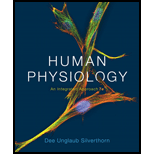
Human Physiology: An Integrated Approach (7th Edition)
7th Edition
ISBN: 9780321981226
Author: Dee Unglaub Silverthorn
Publisher: PEARSON
expand_more
expand_more
format_list_bulleted
Question
Chapter 3, Problem 12RQ
Summary Introduction
Introduction: The tissues which have similar functions combine to form organs. Organs are integrated structures of all major types of tissues. The combination of tissues is different for different organs.
Expert Solution & Answer
Want to see the full answer?
Check out a sample textbook solution
Students have asked these similar questions
Why cells go through various types of cell division and how eukaryotic cells control cell growth through the cell cycle control system?
please make the drawing and steps of whats it asking.
thank you!
please fill in empty spots.
thank you!
Chapter 3 Solutions
Human Physiology: An Integrated Approach (7th Edition)
Ch. 3 - Name three types of lipids found in cell...Ch. 3 - Describe three types of membrane proteins and how...Ch. 3 - Why do phospholipids in cell membranes form a...Ch. 3 - How many phospholipid bilayers will a substance...Ch. 3 - Name the three sizes of cytoplasmic protein...Ch. 3 - How would the absence of a flagellum affect a...Ch. 3 - Prob. 7CCCh. 3 - Prob. 8CCCh. 3 - What is the function of motor proteins?Ch. 3 - What distinguishes organelles from inclusions?
Ch. 3 - Prob. 11CCCh. 3 - Prob. 12CCCh. 3 - Prob. 13CCCh. 3 - Prob. 14CCCh. 3 - Examining tissue from a previously unknown species...Ch. 3 - Prob. 16CCCh. 3 - Prob. 17CCCh. 3 - Prob. 18CCCh. 3 - Prob. 19CCCh. 3 - Name two properties that distinguish endocrine...Ch. 3 - The basal lamina of epithelium contains the...Ch. 3 - You look at a tissue under a microscope and see a...Ch. 3 - Prob. 23CCCh. 3 - What is the distinguishing characteristic of...Ch. 3 - Prob. 25CCCh. 3 - Name six types of connective tissues.Ch. 3 - Prob. 27CCCh. 3 - Why does torn cartilage heal more slowly than a...Ch. 3 - Prob. 29CCCh. 3 - Prob. 1RQCh. 3 - In 1972, Singer and Nicolson proposed the fluid...Ch. 3 - Prob. 3RQCh. 3 - Prob. 4RQCh. 3 - Define cytoskeleton. List five functions of the...Ch. 3 - Match each term with the description that fits it...Ch. 3 - Prob. 7RQCh. 3 - Match each organelle with its function:Ch. 3 - Prob. 9RQCh. 3 - Prob. 10RQCh. 3 - List the four major tissue types. Give an example...Ch. 3 - Prob. 12RQCh. 3 - Prob. 13RQCh. 3 - Prob. 14RQCh. 3 - Prob. 15RQCh. 3 - Prob. 16RQCh. 3 - Which would have more rough endoplasmic reticulum:...Ch. 3 - A number of organelles can be considered vesicles....Ch. 3 - Prob. 19RQCh. 3 - Prob. 20RQCh. 3 - Prob. 21RQCh. 3 - Prob. 22RQCh. 3 - Explain how inserting cholesterol into the...Ch. 3 - Prob. 24RQCh. 3 - Prob. 26RQCh. 3 - Prob. 27RQCh. 3 - Prob. 28RQCh. 3 - Prob. 29RQCh. 3 - One result of cigarette smoking is paralysis of...Ch. 3 - Prob. 31RQCh. 3 - Prob. 32RQ
Knowledge Booster
Similar questions
- please fill in the empty sports, thank you!arrow_forwardIn one paragraph show how atoms and they're structure are related to the structure of dna and proteins. Talk about what atoms are. what they're made of, why chemical bonding is important to DNA?arrow_forwardWhat are the structure and properties of atoms and chemical bonds (especially how they relate to DNA and proteins).arrow_forward
- The Sentinel Cell: Nature’s Answer to Cancer?arrow_forwardMolecular Biology Question You are working to characterize a novel protein in mice. Analysis shows that high levels of the primary transcript that codes for this protein are found in tissue from the brain, muscle, liver, and pancreas. However, an antibody that recognizes the C-terminal portion of the protein indicates that the protein is present in brain, muscle, and liver, but not in the pancreas. What is the most likely explanation for this result?arrow_forwardMolecular Biology Explain/discuss how “slow stop” and “quick/fast stop” mutants wereused to identify different protein involved in DNA replication in E. coli.arrow_forward
- Molecular Biology Question A gene that codes for a protein was removed from a eukaryotic cell and inserted into a prokaryotic cell. Although the gene was successfully transcribed and translated, it produced a different protein than it produced in the eukaryotic cell. What is the most likely explanation?arrow_forwardMolecular Biology LIST three characteristics of origins of replicationarrow_forwardMolecular Biology Question Please help. Thank you For E coli DNA polymerase III, give the structure and function of the b-clamp sub-complex. Describe how the structure of this sub-complex is important for it’s function.arrow_forward
- Molecular Biology LIST three characteristics of DNA Polymerasesarrow_forwardMolecular Biology RNA polymerase core enzyme structure contains what subunits? To form holo enzyme, sigma factor is added to core. What is the name of the structure formed? Give the detailed structure of sigma factor and the function of eachdomain. Please help. Thank youarrow_forwardMolecular Biology You have a single bacterial cell whose DNA is labelled with radioactiveC14. After 5 rounds of cell division, how may cells will contain radioactive DNA? Please help. Thank youarrow_forward
arrow_back_ios
SEE MORE QUESTIONS
arrow_forward_ios
Recommended textbooks for you
 Human Physiology: From Cells to Systems (MindTap ...BiologyISBN:9781285866932Author:Lauralee SherwoodPublisher:Cengage Learning
Human Physiology: From Cells to Systems (MindTap ...BiologyISBN:9781285866932Author:Lauralee SherwoodPublisher:Cengage Learning Human Biology (MindTap Course List)BiologyISBN:9781305112100Author:Cecie Starr, Beverly McMillanPublisher:Cengage Learning
Human Biology (MindTap Course List)BiologyISBN:9781305112100Author:Cecie Starr, Beverly McMillanPublisher:Cengage Learning Biology 2eBiologyISBN:9781947172517Author:Matthew Douglas, Jung Choi, Mary Ann ClarkPublisher:OpenStax
Biology 2eBiologyISBN:9781947172517Author:Matthew Douglas, Jung Choi, Mary Ann ClarkPublisher:OpenStax


Human Physiology: From Cells to Systems (MindTap ...
Biology
ISBN:9781285866932
Author:Lauralee Sherwood
Publisher:Cengage Learning

Human Biology (MindTap Course List)
Biology
ISBN:9781305112100
Author:Cecie Starr, Beverly McMillan
Publisher:Cengage Learning

Biology 2e
Biology
ISBN:9781947172517
Author:Matthew Douglas, Jung Choi, Mary Ann Clark
Publisher:OpenStax

